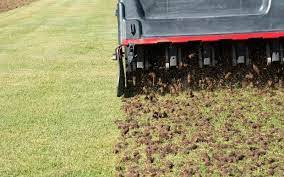What is Lawn Aeration?
Lawn aeration is the process of perforating the soil with small holes to allow air, water, and nutrients to penetrate the grass roots. It involves removing small cores or “plugs” of soil from the lawn to create these holes.4
Aeration helps to alleviate soil compaction, which occurs when foot traffic, mowing equipment, and other activities compress the soil over time. Compacted soil prevents proper circulation of air, water, and nutrients within the soil, which can negatively impact the health of the grass. By puncturing the soil, aeration enables better penetration of oxygen, moisture, and fertilizer to the root system.
Overall, aeration is an important process for improving soil structure and enhancing the quality of established lawns. The small holes and pathways created in the soil facilitate key elements needed for optimal lawn health and performance. For lawn aeration Lee’s Summit, reach out to us!
1. Improves Air Circulation
Aerating your lawn improves air circulation to the grassroots. The process creates small holes in the soil that allow air, water, and nutrients to better reach the grassroots below the surface. This increased airflow promotes the growth of new, dense grass.
When soil becomes compacted, the grassroots have a hard time getting the air they need to thrive. Aeration helps open up the soil and break through compacted areas. The added oxygen stimulates root development and allows the roots to grow deeper and stronger. More robust grassroots make for a lush, healthy lawn.
Aerating improves circulation not just to the roots but also to beneficial microbes in the soil. These microorganisms need air to break down organic material and release nutrients into the soil. Aeration gets them the air they require to do their job. The overall increase in circulation and drainage from aeration leads to greener, more vigorous grass.
Reduces Soil Compaction
Aerating your lawn is a great way to alleviate hard, compacted soil. When soil becomes too compacted, it restricts air and water flow to grassroots. It also prevents roots from expanding and thriving. The spikes and holes created by aerating puncture through compacted soil layers. This helps create small air pockets and space for roots to spread out.
Regular aeration to reduce soil compaction sets the stage for lush, healthy turf. It enables your lawn to access the air, water and nutrients it needs to thrive.
3. Increases Nutrient Absorption
Aerating your lawn improves nutrient absorption by helping fertilizer penetrate the soil more deeply. When soil becomes compacted, it reduces the contact between soil particles and fertilizer granules. The holes created by aerating equipment allow fertilizer to reach deeper below the surface.
In addition, aeration enables deeper root growth so grass plants can access more nutrients from the soil. Compacted soil restricts downward root expansion, limiting the roots to only the top few inches of soil. Aeration relieves this compaction, allowing roots to grow deeper into the newly opened soil. The deeper the roots, the more nutrients the grass can absorb for lush, vigorous growth.
4. Improves Water Drainage
The holes punched into the lawn during aeration allow water to drain more freely through the soil. This avoids waterlogging, which can damage grass by preventing important air circulation to the roots.
Excess watering or heavy rainfall can lead to waterlogged soil, which suffocates grassroots and increases the risk of fungal disease. The compacted soil prevents oxygen from reaching the roots and slows drainage after watering or rain.
Aeration punches holes into the soil to create pathways for excess water to drain down through the lawn. This improves drainage and reduces puddling or standing water on the lawn after irrigation or storms. Proper drainage brings oxygen to the roots and restores optimal growing conditions.
5. Strengthens Grass Roots
Aerating your lawn helps strengthen grass roots by alleviating soil compaction and improving access to water, air and nutrients. When soil becomes compacted, it restricts air circulation and makes it difficult for grass roots to grow and spread properly. The spikes and holes created by aerating penetrate compacted areas, loosening up the soil and creating space for stronger root development.
As aerating reduces compaction, it also allows grass roots to better absorb oxygen, water and nutrients from the soil. Uncompacted soil has more pore space, which enables increased air circulation to the roots. Roots are able to grow deeper and wider to take advantage of more available resources. The improved access to water and nutrients further fuels root growth.
Improve Lawn Health
Aerating your lawn complements other essential lawn care practices like overseeding, fertilizing, and proper mowing. When combined with overseeding, aeration allows new grass seeds better access to the soil so they can establish a strong root system. Fertilizer also penetrates the soil more efficiently after aeration. The improved air and nutrient circulation from aeration encourages healthier, greener, and denser grass. Proper mowing after aeration prevents soil compaction and allows your lawn to fully benefit from the treatment. Aeration combined with proper mowing height, overseeding, and fertilizing improves the overall health and thickness of your lawn. It’s best to aerate at least once a year, either in spring or fall, as part of your seasonal lawn care routine. Aeration works hand in hand with other best practices to strengthen your lawn and keep it lush and green.

